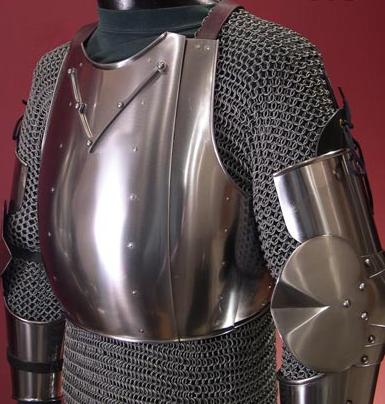Hello I'm Andrew I recently been involved in 14th century reenacting and I'm gonna buy a breast plate soon. From a good friend of mine i've heard there is a european breastplate that has additional plates or peice that wrap around the back just under the ribs of the lower back. He said it was called a globose but all my searches have brought up nothing. maybe I'm spelling it wrong or simply i am wrong. Anyone know what i'm talking about?
Here's what I've got; I don't know the source of the images but I have seen people use these in SCA combat. They look to be a good balance of protection and mobility. They also work better for fighters with a bit of "prosperity" around the middle.
 Attachment: 32.33 KB
Attachment: 32.33 KB


Hi Andrew,
Try a search here on myArmoury or on your favourite search engine for Churburg #13. This is perhaps the most famous of globose breastplates with the wrap-around back.
Darren.
Try a search here on myArmoury or on your favourite search engine for Churburg #13. This is perhaps the most famous of globose breastplates with the wrap-around back.
Darren.
Hello,
Globose refers to the shape of the front of the breast plate - curved outward. It creates a stronger shape and produces glancing surfaces.
All breastplates possess this to one degree or another; it makes them so much more effective then a flat piece of steel. Although there are odd variations like peascod and kastenbrust styles.
The particular style you describe is the Churburg #13. I've seen it referred to as a segmented breastplate. It seems to be an evolutionary step between the Coat of Plates and the proper Breastplate. I'm not aware of any other examples of that particular style besides the piece in the Churburg Armoury. So I believe it to be uncommon (but I'm not certain).
Cheers,
Steven
Globose refers to the shape of the front of the breast plate - curved outward. It creates a stronger shape and produces glancing surfaces.
All breastplates possess this to one degree or another; it makes them so much more effective then a flat piece of steel. Although there are odd variations like peascod and kastenbrust styles.
The particular style you describe is the Churburg #13. I've seen it referred to as a segmented breastplate. It seems to be an evolutionary step between the Coat of Plates and the proper Breastplate. I'm not aware of any other examples of that particular style besides the piece in the Churburg Armoury. So I believe it to be uncommon (but I'm not certain).
Cheers,
Steven
Alright thanks alot guys that was exactly the information I needed
Hi Steven,
That has been the conventional wisdom: that the #13 is a rarity or one-off.
However, there are a number of seeming variations on this theme shown in two of the 'Gladiatoria Group' of combat treatises, both c. 1430, and in a religious manuscript, almost certainly from the same art shop/school, also c. 1430.
At this latter date, they're shown with faulds.
Given the paucity of surviving torso defenses from the 14th c., we need to look farther afield to find this stuff.
Cheers,
Christian
That has been the conventional wisdom: that the #13 is a rarity or one-off.
However, there are a number of seeming variations on this theme shown in two of the 'Gladiatoria Group' of combat treatises, both c. 1430, and in a religious manuscript, almost certainly from the same art shop/school, also c. 1430.
At this latter date, they're shown with faulds.
Given the paucity of surviving torso defenses from the 14th c., we need to look farther afield to find this stuff.
Cheers,
Christian
| Christian Henry Tobler wrote: |
|
However, there are a number of seeming variations on this theme shown in two of the 'Gladiatoria Group' of combat treatises, both c. 1430, and in a religious manuscript, almost certainly from the same art shop/school, also c. 1430. At this latter date, they're shown with faulds. |
Thanks for the info. Could you point me to a picture of this?
Cheers,
Steven
| Gavin Kisebach wrote: |
| They also work better for fighters with a bit of "prosperity" around the middle. |
In those cases, the breastplate fit is sometimes somewhat incorrect... the bottom usually comes to about the bottom of the floating ribs (at least in the late 14th C / early 15th C italian and german syles) - not so far down as the waist. Though I believe the much later Peascod styles did.
Page 1 of 1
You cannot post new topics in this forumYou cannot reply to topics in this forum
You cannot edit your posts in this forum
You cannot delete your posts in this forum
You cannot vote in polls in this forum
You cannot attach files in this forum
You can download files in this forum
All contents © Copyright 2003-2006 myArmoury.com — All rights reserved
Discussion forums powered by phpBB © The phpBB Group
Switch to the Full-featured Version of the forum
Discussion forums powered by phpBB © The phpBB Group
Switch to the Full-featured Version of the forum